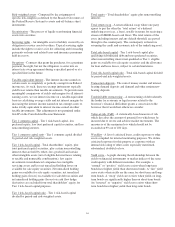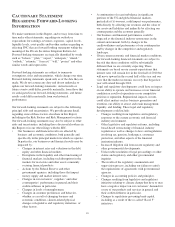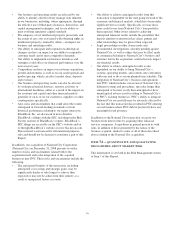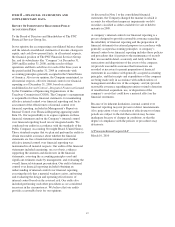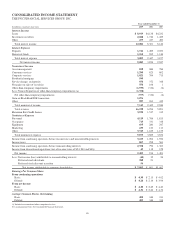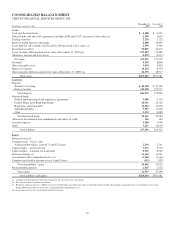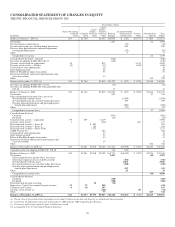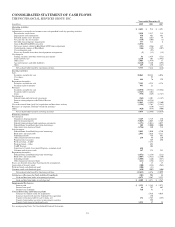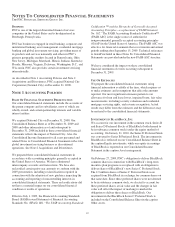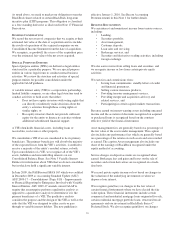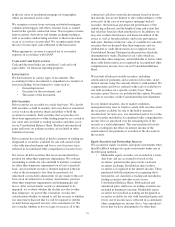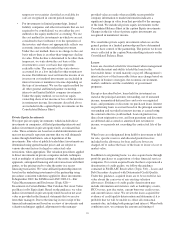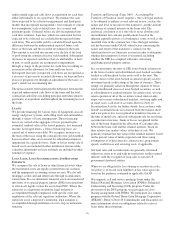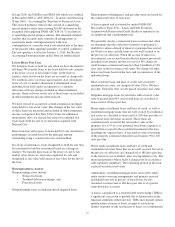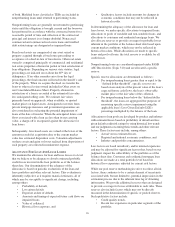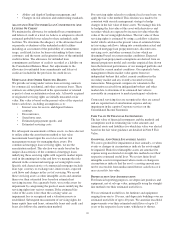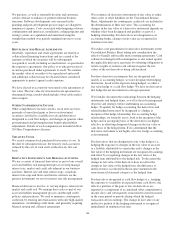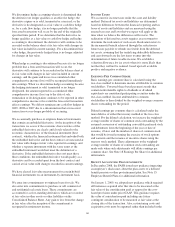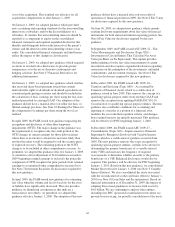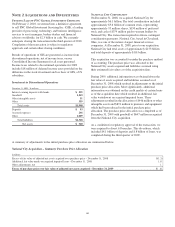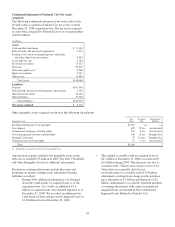PNC Bank 2009 Annual Report Download - page 98
Download and view the complete annual report
Please find page 98 of the 2009 PNC Bank annual report below. You can navigate through the pages in the report by either clicking on the pages listed below, or by using the keyword search tool below to find specific information within the annual report.in the fair value of residential mortgage servicing rights,
which are measured at fair value.
We recognize revenue from servicing residential mortgages,
commercial mortgages and other consumer loans as earned
based on the specific contractual terms. We recognize revenue
from securities, derivatives and foreign exchange trading as
well as securities underwriting activities as these transactions
occur or as services are provided. We recognize gains from
the sale of loans upon cash settlement of the transaction.
When appropriate, revenue is reported net of associated
expenses in accordance with GAAP.
C
ASH AND
C
ASH
E
QUIVALENTS
Cash and due from banks are considered “cash and cash
equivalents” for financial reporting purposes.
I
NVESTMENTS
We hold interests in various types of investments. The
accounting for these investments is dependent on a number of
factors including, but not limited to, items such as:
• Ownership interest,
• Our plans for the investment, and
• The nature of the investment.
Debt Securities
Debt securities are recorded on a trade-date basis. We classify
debt securities as held to maturity and carry them at amortized
cost if we have the positive intent and ability to hold the
securities to maturity. Debt securities that we purchase for
short-term appreciation or other trading purposes are carried at
fair value and classified as trading securities and other assets
on our Consolidated Balance Sheet. Realized and unrealized
gains and losses on trading securities are included in other
noninterest income.
Debt securities not classified as held to maturity or trading are
designated as securities available for sale and carried at fair
value with unrealized gains and losses, net of income taxes,
reflected in Accumulated other comprehensive income (loss).
We review all debt securities that are in an unrealized loss
position for other-than-temporary impairment. We evaluate
outstanding available for sale and held to maturity securities
for other-than-temporary impairment on at least a quarterly
basis. An investment security is deemed impaired if the fair
value of the investment is less than its amortized cost.
Amortized cost includes adjustments (if any) made to the cost
basis of an investment for accretion, amortization, previous
other-than-temporary impairments and hedging gains and
losses. After an investment security is determined to be
impaired, we evaluate whether the decline in value is other-
than-temporary. As part of this evaluation, we take into
consideration whether we intend to sell the security or whether
it is more likely than not that we will be required to sell the
security before expected recovery of its amortized cost. We
also consider whether or not we expect to receive all of the
contractual cash flows from the investment based on factors
that include, but are not limited to: the creditworthiness of the
issuer and, in the case of non-agency mortgage-backed
securities, the historical and projected performance of the
underlying collateral; and the length of time and extent that
fair value has been less than amortized cost. In addition, we
may also evaluate the business and financial outlook of the
issuer, as well as broader industry and sector performance
indicators. Declines in the fair value of available for sale debt
securities that are deemed other-than-temporary and are
attributable to credit deterioration are recognized on our
Consolidated Income Statement in the period in which the
determination is made. Declines in fair value which are
deemed other–than-temporary and attributable to factors other
than credit deterioration are recognized in Accumulated other
comprehensive income (loss) on our Consolidated Balance
Sheet.
We include all interest on debt securities, including
amortization of premiums and accretion of discounts, in net
interest income using the constant effective yield method. We
compute gains and losses realized on the sale of available for
sale debt securities on a specific security basis. These
securities gains/ (losses) are included in the caption Net gains
on sales of securities on the Consolidated Income Statement.
In very limited situations, due to market conditions,
management may elect to transfer certain debt securities from
the securities available for sale to the held to maturity
classification. In such cases, any unrealized gain or loss at the
date of transfer included in Accumulated other comprehensive
income (loss) is amortized over the remaining life of the
security as a yield adjustment. This amortization effectively
offsets or mitigates the effect on interest income of the
amortization of the premium or accretion of the discount on
the security.
Equity Securities and Partnership Interests
We account for equity securities and equity investments other
than BlackRock and private equity investments under one of
the following methods:
• Marketable equity securities are recorded on a trade-
date basis and are accounted for based on the
securities’ quoted market prices from a national
securities exchange. Dividend income on these
securities is recognized in net interest income. Those
purchased with the intention of recognizing short-
term profits are classified as trading and included in
trading securities and other assets on our
Consolidated Balance Sheet. Both realized and
unrealized gains and losses on trading securities are
included in noninterest income. Marketable equity
securities not classified as trading are designated as
securities available for sale with unrealized gains and
losses, net of income taxes, reflected in accumulated
other comprehensive income (loss). Any unrealized
losses that we have determined to be other-than-
94


